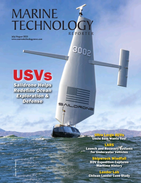EcoLight AZFP Buoy to Monitor Light and Under-Ice Zooplankton
A team of scientists led by Dr. Giulia Castellani of the Alfred Wegener Institute (AWI) and Dr. Jeremy Wilkinson of the British Antarctic Survey (BAS) have developed a project called EcoLight which uses an Autonomous Biological Echo Sounding Buoy (ABES) to continuously measure changes in the light field and associated biological responses under sea ice.
The buoy is designed to be frozen into the ice and drift for deployment periods of one to two years collecting data on a pan-Arctic scale. Its payload of instruments includes a holistic array of sensors to measure sea ice, snow, the physical properties of seawater and the biological communities beneath the ice. Fundamental to these biological communities is the availability, timing and duration of light. With climatic changes occurring in polar regions, the overall goal of the ABES buoy deployments is to demonstrate how Arctic ecosystems may change as snow, ice type and thickness change in the future. Changes in the light field under the ice affect large-scale ecosystem structure and biochemical functioning of the Arctic marine environment. The consequences of changes in light penetration impact phytoplankton blooms and in-ice algal growth and this in turn impacts feeding opportunities throughout the food web.
A key instrument integrated into the ABES is an ASL Environmental Sciences Acoustic Zooplankton Fish Profiler (AZFP) . This instrument provides high spatial and temporal resolution and can monitor the presence and abundance of zooplankton and fish within the water column by measuring acoustic backscatter returns at multiple ultrasonic frequencies.
The buoy has solar panels and a set of rechargeable and non-rechargeable backup batteries. In the summer, when there is abundant solar power, the buoy will sample for 20 minutes every two hours, limited by the amount of data that can be transferred via the Iridium satellite modem connection. In the winter, the buoy will sample for six minutes every three hours, limited mostly by available backup battery capacity. This satellite link is bi-directional allowing for the downloading of data as well as the ability to reconfigure instrument parameters remotely.
Others involved in this project include Dr. Lovro Valcic (Bruncin Observation Systems); Dr. Julienne Stroeve (University College London); Dr. Michael Karcher (Ocean Atmosphere Systems—OASys); Dr. Hauke Flores (AWI); Dr. Gaëlle Veyssiere (BAS); Dr. Marcel Nicolaus (AWI); Dr. Frank Kauker (OASys); Dr. Mario Hoppmann (AWI) and Dr. Joo-Hong Kim and Dr. Eun-Jin Yang (Korean Polar Research Institute—KOPRI).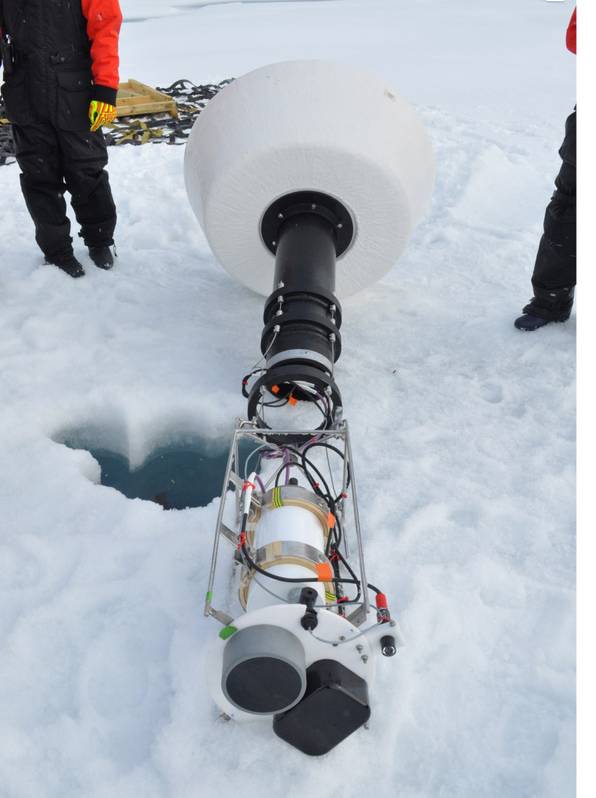 AZFP zooplankton sensor in its frame, attached to the buoy hull before deployment next to the prepared deployment hole in the sea ice. Photo by Dr. Lovro Valcic.
AZFP zooplankton sensor in its frame, attached to the buoy hull before deployment next to the prepared deployment hole in the sea ice. Photo by Dr. Lovro Valcic.

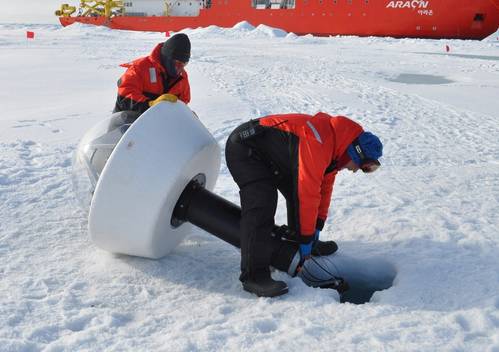
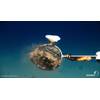
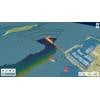










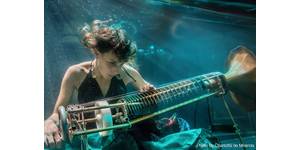
 August 2025
August 2025


